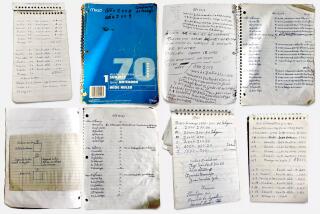Woman Banking On $46 Billion--if Courts Give the OK
MEXICO CITY — If she keeps winning court decisions against a Mexican bank, 82-year-old widow Celia Reyes could end up rubbing shoulders with Bill Gates. By her lawyer’s count, her original $24,000 deposit in 1988 is now worth more than $46 billion.
Lawyers for Banco del Atlantico scoff at such calculations, putting Reyes’ maximum claim at something like $150,000. And they’re fighting her all the way.
Still, the case has fascinated Mexicans, who have more often been on the losing end of bank disputes. Decades of economic crises, sudden bursts of inflation and devaluations of the peso regularly sent Mexican interest rates through the roof. That made loans unpayable and forced tens of thousands of people to forfeit houses and other assets.
This time, the sky-high interest rates of years past could work in a consumer’s favor. Reyes made her deposit in February 1988, when the annual interest rate peaked at 149.35%. Her claim is that she never withdrew the money or changed the terms of her investment. So her original deposit, plus monthly compound interest, her lawyer asserts, kept growing astronomically, to a sum that would be greater than Mexico’s entire foreign currency reserves.
The $46-billion calculation was made by a court-appointed accountant in mid-1999. Using his methodology, the amount now would be about $2.3 trillion.
“The nominal figure may be unreal, but the obligation to pay is absolutely real, just as in the 300,000 cases where banks have won judgments condemning debtors to pay far more than the total of their assets,” said Reyes’ lawyer, Mario Alberto Canales. “Those judgments are carried out until they take all the assets the debtor owns.”
Reyes has already won a Mexico City court case and an appeal by the bank, the result of which is that she is owed the principal plus interest--although the legal battle over how to calculate that interest remains to be fought. A final appeal before the Supreme Court remains, in which the bank is challenging the constitutionality of the earlier rulings.
In fact, Reyes doesn’t want to be paid out such a sum. Her lawyer suggests that they’ll negotiate a realistic settlement--and that most of the payout wouldn’t go to Reyes.
Victor Blake Gomez, head of a debtors action group, said he agreed in 1999 to take on the Reyes case only if she agreed that any windfall would be used to create an education trust fund. Reyes and her heirs--she had 19 children, 15 of whom are still living--would receive a portion of the interest from the trust fund.
The bank, which was devastated by Mexico’s 1994-95 peso crisis, didn’t appear to take the case seriously at first, much to its later regret. It lost the original case when it couldn’t produce receipts or other documentation that could have proved that Reyes’ contract called for floating interest rates to apply to such investments.
The bank later found documents it claims proved that one of Reyes’ sons actually withdrew the deposit about three months after it was made. But that claim couldn’t be used as evidence because it wasn’t introduced in the first trial.
Blake says that allegation is untrue, as well as inadmissible, designed to distract attention from the basic question of justice at stake.
Reyes told a television interviewer recently: “If you can’t have confidence in depositing your savings in a bank and in the justice system that should defend us, then what can you trust?”
Even if Reyes wins the final appeal, a separate, lengthy procedure would have to follow to determine the current value of the claim. The bank would then press its argument that the floating interest rate applies, which would drastically reduce any payout.
Bank lawyer Javier Sainz said: “There’s no point in speaking about figures that don’t appear anywhere, that only exist in someone’s head. In all transactions in Mexico, the interest rate floats. Any adult knows that investments were of this nature.”
Reyes’ husband, Walfre Nieto Reyes, started out as a metalworker in the state of Michoacan. He later set up a small foundry that was successful enough to generate profits, allowing the couple to make the 1988 deposit, in both their names.
She has the original deposit receipt, which Blake argues is like a check: She would have had to turn it over to the bank if the money had been withdrawn. Blake also says the terms on the receipt could not be modified without agreement between the bank and the depositor, so the original interest rate prevails for the duration of the certificate of deposit.
The bank later found additional receipts reflecting lower interest rates: Just one month after the original deposit, the rate plummeted to 86% in March and 60% in April 1988. Typical interest rates now for such certificates of deposit are about 5% to 6%.
Bank officials have contended that later research showed that in June 1988, Reyes’ son Mario, who had signing power, withdrew all the money, which the bank says was then worth about $30,000, and made an immediate deposit of that amount in his own account. But a court ruling threw out that argument early on, and the case went forward.
During the original trial, a forensic accountant appointed by the judge calculated the total value of the claim. The accountant accepted the argument that the 149% interest rate prevailed through the duration of the deposit and came up with a figure of 440 billion pesos as of 1999. That would be about $46 billion.
Just before the accountant’s calculations were to be submitted to the trial court, the bank’s lawyers moved successfully to exclude all such calculations. Because that motion was approved, there are in fact no official calculations of the value of the claim, beyond the original principal investment.
Sainz, the bank’s lawyer, notes that the lower-court verdict in January said simply that the bank owes Reyes the principal, and does not discuss the value of the interest, which would be calculated in a separate proceeding. Blake accepts that more proceedings will follow to decide the value of the payout.
In 1999, Antonio del Valle, then-chairman of Bital Bank, which is acquiring Atlantico, called the Reyes case “a fantasy, an absurdity, a total lie, a barbarity.” In an interview with Excelsior newspaper, Del Valle noted that all Mexican banks were owned by the government in 1988, when the deposit was made.
Atlantico was privatized in 1992 and was bailed out by the government in 1996, along with most other banks. Therefore, any payout to Reyes would come not from Atlantico but from the government Banking Insurance Agency.
Blake, a computer engineer, says he got involved in defense of bank customers after he felt the sting of the debt collectors. In 1995, at the height of the crisis, the floating-rate mortgage repayments on the modest house that serves as his office suddenly increased fivefold. He was able to keep the house only because he borrowed money from a brother.
“The situation has been killing debtors,” Blake said. “The only difference [in the Reyes case] is that now the bank is on the other side.”
“Until now,” he added, “everybody thought that the bank could never lose, right or wrong, because the system protected it. . . . You can see in this case a test of whether the rule of law is really developing in Mexico. Courts now are starting to give truly independent judgments.”
More to Read
Sign up for Essential California
The most important California stories and recommendations in your inbox every morning.
You may occasionally receive promotional content from the Los Angeles Times.










